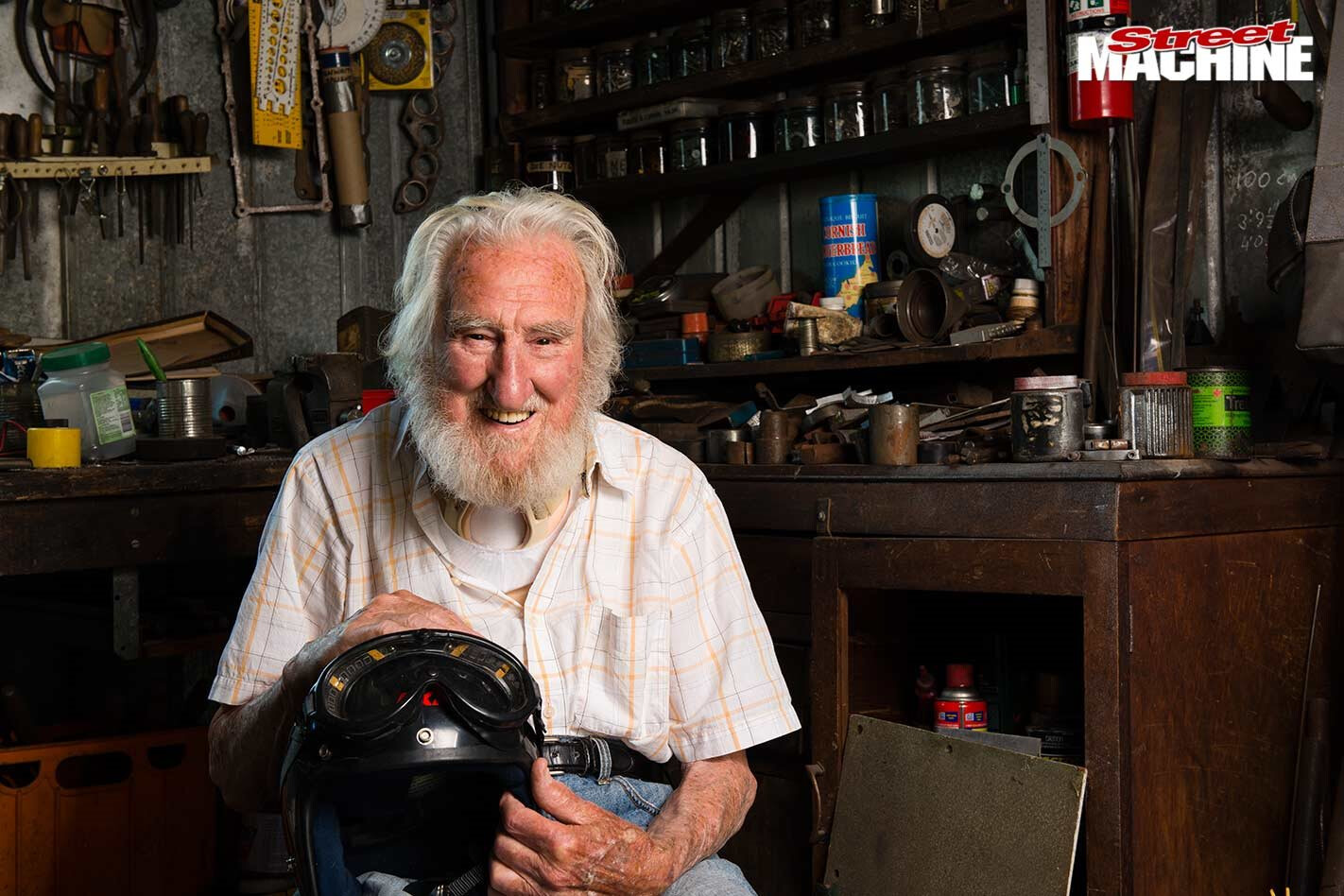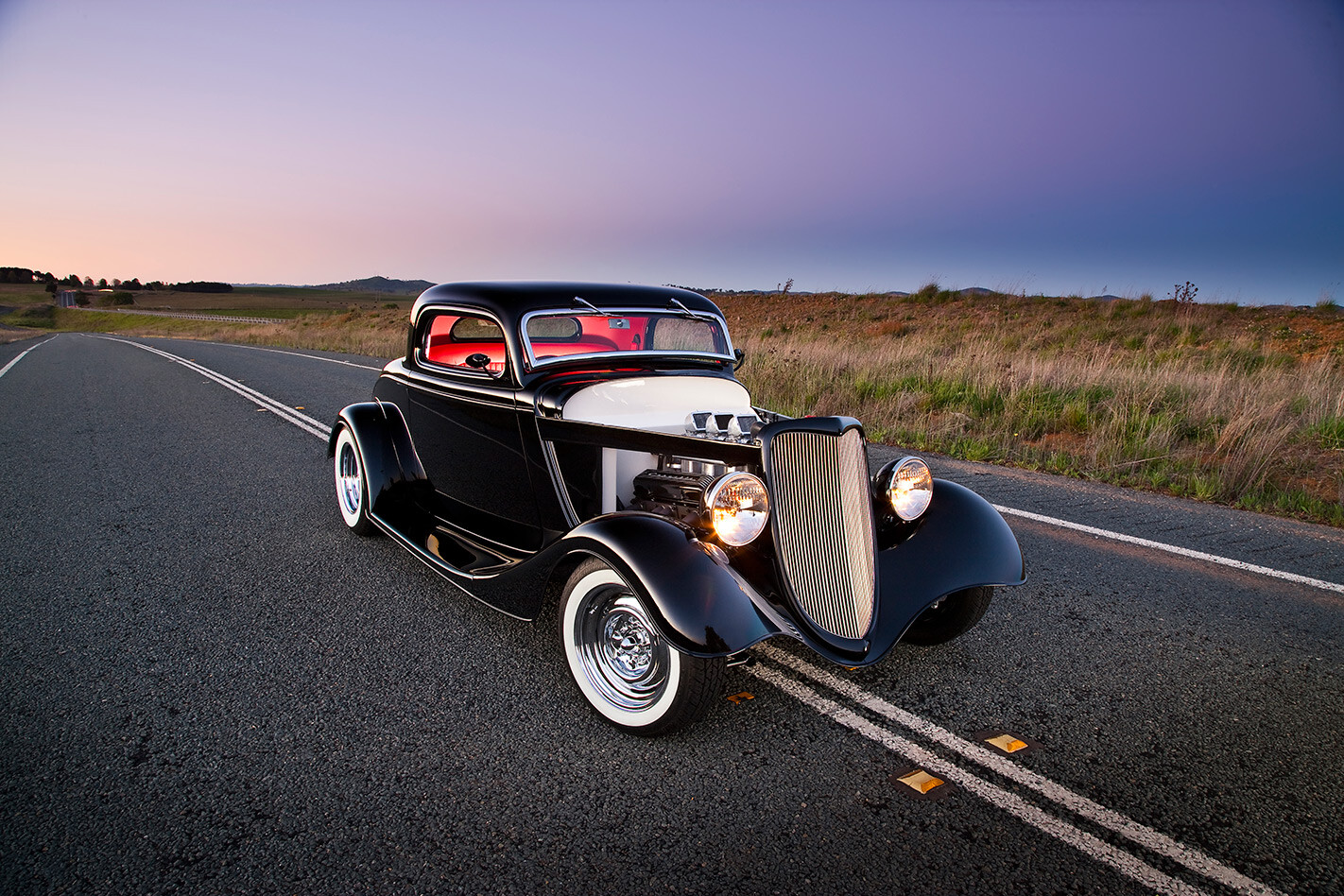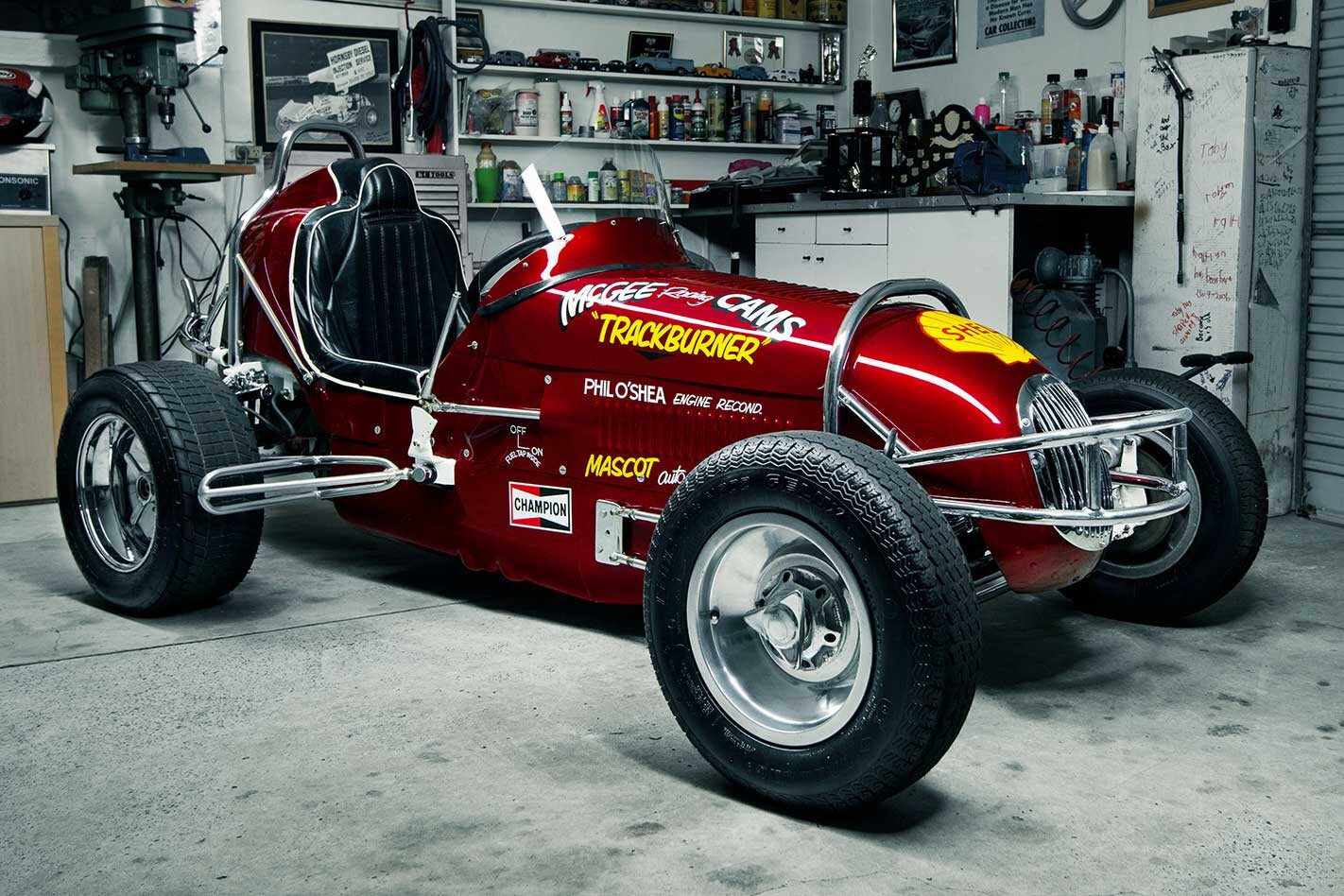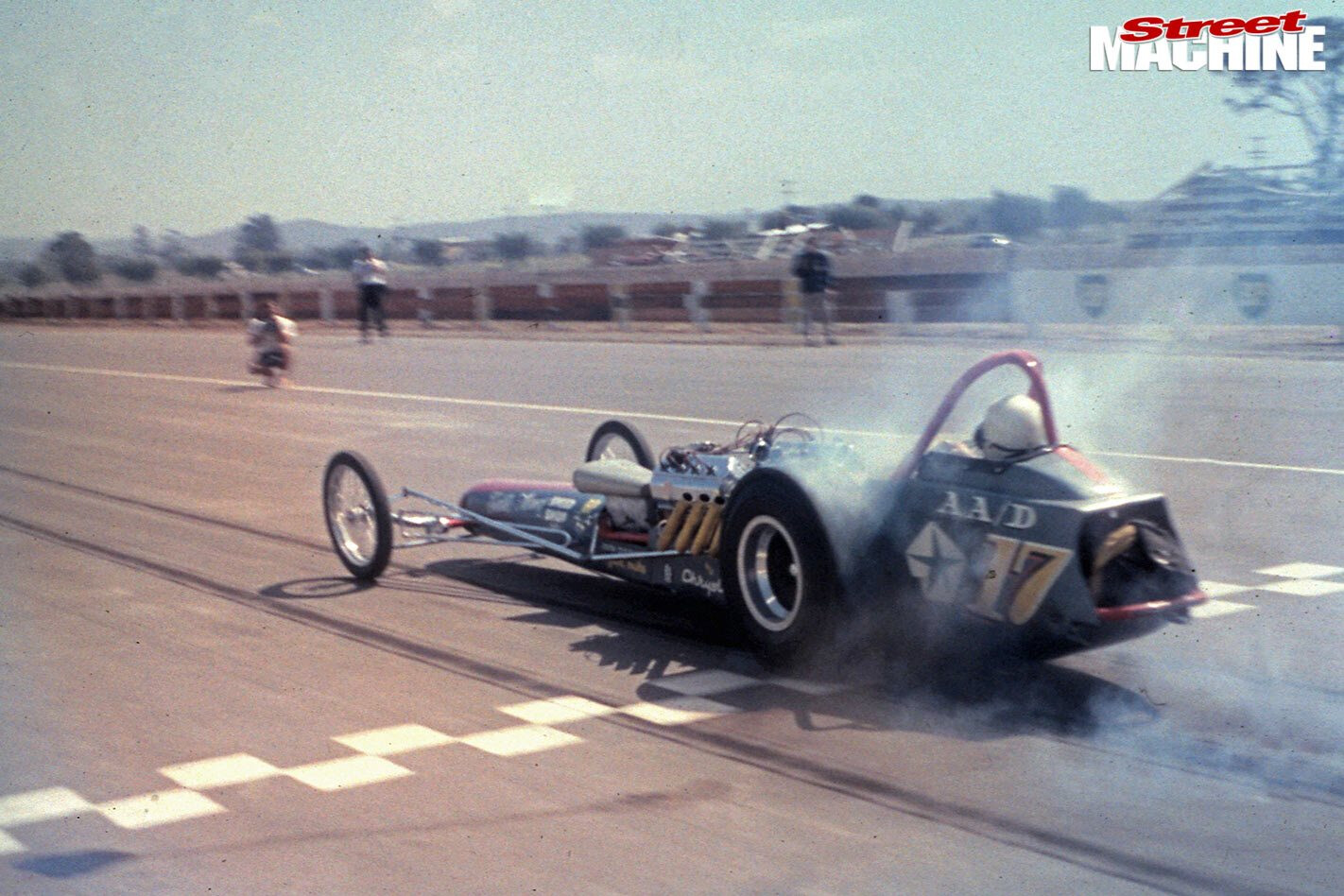This article on Ken Izzard was first published in Street Machine’s Hot Rod magazine #13, 2014
SOME people just know how to have a good time, they make their own fun. They don’t sit around waiting for something to happen, they get involved. Ken Izzard knows all about having a good time, and he loves racing. For Ken it was one of the purest and the grittiest forms of racing — speedway. To some people, an earache and a mouthful of dirt doesn’t sound like much fun, but open wheel, open topped midget racing is just as pure as it gets.
They’ve been called various things over the years; Speed Cars, Junior Speed Cars, Compact Speed Cars but whatever they were called these tiny bike-engined racers were in Ken’s blood. When low profile rear-engined cars appeared, they were competitive but they were also dangerous in a mixed field because they were harder to see among the higher front-engined cars. Progress marched on and the traditional front-engined cars continued to race in their own class as Junior Speed Cars. Since then TQs or Three-Quarter midgets have been largely a historic affair raced by enthusiasts like Ken.
Ken was enlisted during the Second World War in the Engineers and saw service late in the war in Darwin. Not many people know it, but the Japanese dropped more bombs there than Pearl Harbour. Fortune had it that while Ken was down south for further study his unit was sent to Borneo, and shortly after, the war ended.
Ken worked his way up to superintendent of the Ansett workshops in Melbourne while he raised a family in Maribyrnong, just near what was then Tracey’s Speedway. Originally called Kirjon Speedway before being taken over after the war by Fred Tracey, a motorbike racer and born promoter, one story has a field running at speed round the track while Tracey rode in the opposite directSOion. Thousands went to the races on Wednesday and Saturday nights, among them a young Ken, who was determined he too would race.
Ken’s first foray into racing was through hill climbs in a home built open wheeler using part of a Meteor bellytank as a body, a Matchless 500 single, a Fiat 500 front end and a bunch of moly tube. Starting with some lines drawn on the floor, he combined his aircraft engineer’s knowledge and skill with a true home-built ethos that put form and function on an even par, building a beautiful, unique racer and one of the first in Australia to use a bellytank.
Double A-arms at the front and a coil-over rear with chain drive made for a light and quick car. One of Channel Ten’s first motorsports broadcasts was of the Templestowe Hill Climb in the late 50s. The course included Australia’s steepest piece of paved road with a 40 per cent gradient. Searching for more speed, Ken wound his brake shoes off and went in with a heavy slipper in pursuit of Bruce Walton’s 1:06min record, only to leave the track over a steep embankment known as The Wall. Monday morning at work was interesting as Ansett owned Channel Ten and it seemed every man and his dog had been watching the telly on Saturday afternoon and Ken’s off course antics.
Ken bought the Des Nash car in 1983 after finding it in Whyalla. He’d recognised the tail which was the only piece of original bodywork and had been formed by the panel beating instructor at Collingwood Tech. It was built by the Beasley family, well known midget builders, in 1956
Tracey’s closed in ’63 while Ken was still busy with the hill climbs but his speedway time would come. He joined the Victorian Junior Speed Car Club and raced all over Victoria and sometimes interstate, Brooklyn, Garfield, Rosedale, Bendigo and the shell-grit track at Ocean Grove — where the water truck was filled with salt-water — Warnambool, Swan Hill, Myrtleford, Avalon. He trailered to the Sydney Showgrounds, Ekka in Brisbane and even Rockhampton for the Australian titles, long before freeways, cruise control or air-con.
It runs an Ariel Red Hunter 500 with a magneto, an Austin 7 front end and steering box, an SU remote fuel bowl with an exhaust pulse diaphragm fuel pump and Amal carb. It is direct drive with a slider quick-change made from two Austin A7 diffs. The gears are a second gear from a Holden three-speed and the suspension is Morris 1000 torsion bar with hydraulic brakes to the rear only
Ken had heart trouble when he was 60 and spent 12 months on the sidelines, then he raced a full-sized midget for a time, but you can’t keep a good man down. After three years he went back to the three-quarter cars until he turned 70. Since then he has run demonstrations and concentrated on restorations, but, you see, that was 20 years ago.
The #17 car has a home-built front end with Morris 1000 torsion bars. A Triumph Speed Twin 498, remote SU bowl, exhaust pulse pump and Amal carb for power and an Austin 7 gearbox with only top gear. Austin 7 rear end, coil-overs, mechanical brakes, Austin 7 steering box and Ken Izzard built suspension, cage and chassis
Most recently Ken drove some exhibition laps at the Nationals at Ballarat in the #17 car before the main event. He tells us with a grin on his face that he’d really only just finished the build — the car can’t be classed as a historic because he’d had to build a new full chassis — the bulk of the car though was his son Neil’s former racer. The exhibition lap started with a push car and being so cold it was taking a while to start, but eventually the Triumph Speed Twin fired and he headed out behind the course marshal in his pace car under instructions: “Not to pass him under any circumstances.”
In the rebuild Ken had opted for a flex-joint rather than a uni-joint which had necessitated a slightly larger tunnel, hitting the end of the straight at full throttle Ken realized that this slightly larger tunnel had jammed his foot flat on the throttle. Thinking quickly and not wanting to end his run early Ken switched the ignition off and threw the car into the corner, nearing the exit he snapped it back on and the Trumpy snarled back to life with a flick of the rear, Ken kept this up for a couple of turns until a combination of the looming pace car and a chance to scoot into the pits came up. Sitting in the stands an old mate of Ken’s had thought to himself: “Gee, ol’ Ken’s giving it some stick,” and he was, full stick!
We look over old black and white photos, one of Ken’s #16 car upside down, pile ups and more busted and dinged up stuff amongst the beautiful colour pics of the cars looking their finest. Ken is still actively building, restoring and maintaining cars. So much so that it became a problem. There are holes cut on either side of his garage door and some in the door itself, they are, as Ken said: “So my son could chain the door shut and stop me getting in here to work on the cars when I broke my neck.”
Broken neck? Yes, Ken tripped over early last year crossing the road and broke his C1 vertebra. Nine months later he is still sporting a neck brace and is keen to point out that he: “Only broke one egg when I fell, and, um, one vertebra.” He’s still living at home and the chains are off the shed door. When we got there Ken had pushed both the midgets out and was busy discussing work he had planned. Like we said, you can’t keep a good man down.




Comments